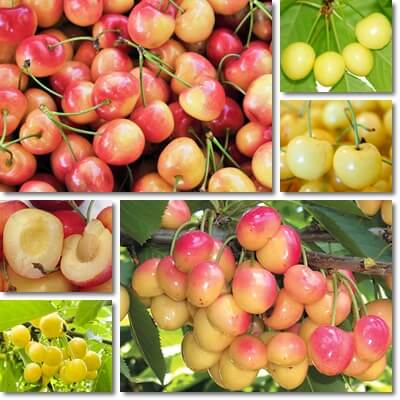Yellow cherries are a variety of sweet cherry with yellow skin and blushed red. In terms of nutrition, yellow cherries are higher in vitamin A and an overall good source of vitamin C, potassium, magnesium and manganese. Unlike red and black cherries, yellow ones are higher in carotenes and xanthophyll antioxidants such as beta-carotene, lutein and zeaxanthin, but lower in anthocyanins. Yellow cherries have antioxidant, anti-inflammatory and anticancer properties and hold benefits for digestion, blood pressure, diabetes, gout and arthritis as well as prebiotic and antiaging benefits.
What are yellow cherries?
Yellow cherries are a variety of sweet cherry (Prunus avium). Despite their name, not all yellow cherry varieties are entirely yellow. While there are some varieties that are a pale to golden yellow all over, most yellow cherries are blushed red, pink-red or orange-red. The reason why they’re called ‘yellow cherries’ is to distinguish them from the more common red cherries which are the standard sweet cherry color variety.
Growing yellow cherries is similar to growing regular red cherries: the trees are hardy, most varieties tolerating down to -30 degrees Celsius in winter, and can adapt to most soil types successfully, only requiring regular watering and at least 6 hours of full sun. You can get yellow cherry tree varieties such as Rainier, Royal Ann, Emperor Francis or White Gold at local tree nurseries or online.

What do yellow cherries look like?
Not all yellow cherries are entirely yellow. For the most part, the sweet cherry varieties referred to as ‘yellow cherry’ are actually red and yellow cherries. The fruits typically have a cream or pale yellow skin that is blushed red, pink-red or orange-red. The extent of the blush of color depends on the variety, growing conditions and other factors.
Unlike the skin, the flesh or pulp of yellow cherries is typically one color, usually a cream color or pale yellow, depending on the variety (although it can be blushed). There are also yellow cherry varieties that are entirely yellow, skin and flesh. The skin is either a lighter yellow or a golden yellow, while the flesh is cream or pale yellow.
Yellow cherries varieties that are yellow all over are often referred to as white cherries.
The fruits themselves have a typical appearance: plump and lightly heart-shaped, with a thin furrow on one side, along the length of the fruit. The skin is thin and smooth and bruises easily; the bruising is more visible on yellow cherries compared to red or black cherries.
The flesh ranges from firm to juicy. Each fruit has one smooth, hard-shelled, brown stone or pit in the center enclosing one white, bitter seed. The fruits are in season from roughly mid-June to mid-July.
What do yellow cherries taste like?
Yellow cherries are one of the sweeter varieties of cherries. In addition to a higher sugar content, yellow cherries are also not acidic which emphasizes their sweet taste and fruity flavors. There may be some bitterness, especially around the pit, if they fruits are underripe. However, ripe yellow cherries should not taste bitter.
Depending on the variety, yellow cherries can be juicier, with less pulp, or meatier, with a firm, but fresh and juicy flesh such as Rainier cherries.

Yellow cherries nutrition information
Yellow cherries are essentially a different-colored variety of red cherries so it makes sense that the nutrition of yellow cherries is the nutrition of regular red cherries, with a few exceptions. For the most part, yellow cherries are a good source of vitamin A from carotenoid antioxidants, as well as vitamin C and potassium, and a modest source of iron, copper, phosphorus and manganese. The fruit also contains small amounts of vitamin K and several B vitamins (B1, B2, B3, B5, B6 and B9) and trace amounts of vitamins E, zinc and calcium.
Yellow cherries vs red cherries nutrition
The first big nutritional difference between yellow and regular red cherries is a higher sugar content (and lower acidity) that accounts for the sweeter taste of the first. Depending on the variety, yellow cherries may be 15% to 30% sweeter than red cherries.
The second biggest nutritional difference is the antioxidant profile. More specifically, yellow cherries are higher in pigmented carotenoids such as yellow-orange carotenes (beta-carotene, alpha-carotene) and yellow xanthophylls (lutein, zeaxanthin) and lower in anthocyanins. Vs red and black cherries which are higher in anthocyanins (anthocyanins which give off the colors red, purple, blue and black in food).
Yellow cherries nutrition facts per 100 g:
- Energetic value: 60+ kilocalories (kcal)
- Fat: 0.2 g
- Protein: around 1 g
- Carbohydrates: 19 g
- Sugars: 13.5+ g
- Dietary fiber: around 2 g
Vitamins in yellow cherries:
- Vitamin A: exact content is undetermined, but presumed higher than in red and black cherries (yellow cherries are higher in carotenoids that are precursors of vitamin A)
- Vitamin B1: 0.027 mg
- Vitamin B2: 0.033 mg
- Vitamin B3: 0.154 mg
- Vitamin B5: 0.199 mg
- Vitamin B6: 0.049 mg
- Choline: 6.1 mg
- Vitamin B9: 4 mcg (micrograms)
- Vitamin B12: 0 mcg
- Vitamin C: 9.6 mg
- Vitamin D: 0 mcg
- Vitamin E: 0.07 mg (trace amounts)
- Vitamin K: 2.1 mcg
Minerals in yellow cherries:
- Calcium: 13 mg
- Copper: 0.06 mg
- Iron: 0.36 mg
- Magnesium: 11 mg
- Manganese: 0.07 mg
- Phosphorus: 21 mg
- Potassium: 222 mg
- Selenium: 0 mcg
- Sodium: 0 mg
- Zinc: 0.07 mg
What are yellow cherries good for?
- Good for constipation. Yellow cherries have natural laxative properties and help regulate digestion and transit, relieving constipation.
- Good for weight loss. Low-calorie and low-fat, yellow cherries can help with healthy weight loss, provided they are consumed reasonably (they are higher in sugar than other varieties).
- Prebiotic benefits. Yellow cherries have prebiotic properties, feeding good gut bacteria for a healthier gut environment and better digestive health.
- Good for stomach upset. Yellow cherries are low in organic acids, hence their lack of acidity. This makes them easy on the stomach and a good food to eat for stomach upset.
- Good for blood pressure. Eating yellow cherries provides potassium and magnesium to help lower blood pressure numbers. The cherries are also sodium-free, making them an overall good food for high blood pressure.
- Benefits for teeth and gums thanks to a good vitamin C content which is vital for healthy teeth and gums. Vitamin C deficiency manifests as bleeding gums and tooth loss.
- Good food for high blood sugar. While higher in sugar than other varieties, yellow cherries do not raise blood sugar levels too much too fast when eaten in reasonable amounts.
- Good food for diabetes. With a moderate glycemic index score, yellow cherries are safe to eat with diabetes because they do not raise blood sugar levels excessively, provided intakes are reasonable. They are a good source of fiber, vitamins and minerals with benefits for diabetics.
- Antioxidant benefits. Yellow cherries are an important source of carotenoid antioxidants (alpha-carotene, beta-carotene, lycopene) and xanthophyll antioxidants (lutein, zeaxanthin, cryptoxanthin) as well as limited amounts of anthocyanins, and other polyphenols. Antioxidants are biologically active and scavenge free radicals and help repair cell damage caused by oxidative stress.
- Anticancer properties. Yellow cherries exert antioxidant and reparative effects at cell level, as well as anti-proliferative, anti-tumor and anticarcinogenic effects.
- Anti-aging benefits. Thanks to antioxidant vitamin C, vitamin A, iron, copper, manganese, carotenoids, anthocyanins and other biologically active antioxidants. Antioxidants in the fruit help prevent and repair cell damage caused by oxidative stress and delay premature aging, exerting antiaging benefits. Vitamin C further supports collagen production for better skin elasticity and a more youthful looking skin.
- Good food for gout. Naturally low in purines, yellow cherries and cherries in general are a good food to eat for the condition and help reduce the risks of flareups. See what are the benefits of cherries for gout.
- Anti-inflammatory benefits. Yellow cherries are an anti-inflammatory food and regular consumption can help reduce levels of inflammation in the body, resulting in benefits for inflammatory conditions such as arthritis. The anti-inflammatory properties are owed to antioxidants in the fruit, including carotenes, xanthophylls, anthocyanins and other polyphenols.
Find out more about the benefits of cherries and cherry juice for arthritis pain.
Note: It’s not clear at this moment if yellow cherries have the same anti-inflammatory range of benefits as red and black cherries due to the difference in antioxidant profile. Studies show red and black cherries owe their wonderful anti-inflammatory benefits to red, purple and black anthocyanin antioxidants, which yellow varieties are lower in, but that does not exclude other antioxidants specific to yellow cherries providing similar anti-inflammatory benefits.
What are the side effects?
Allergic reactions
Eating yellow or other types of cherries can cause an allergic reaction. Symptoms of a cherry allergy include: rash (hives), tingling of the lips, tongue or throat, swelling of the lips, tongue or throat, sneezing, wheezing, difficulty breathing, closing of the airways, asthma attacks, low blood pressure, shortness of breath, low blood pressure and anaphylactic shock. Find out more about cherry allergy.
Loose stools and diarrhea
Yellow cherries can cause loose stools and diarrhea if eaten in excess or if you have a dietary intolerance to components occurring naturally in the fruit such as the sugar alcohols sorbitol or mannitol.
Stomach upset
Eating too many yellow cherries (or other colors), or having a sensitivity or intolerance to components occurring naturally in the fruit such as some sugars, can give you gas and cause stomach upset and associated symptoms such as stomach pain, bloating, hiccups and burping.
